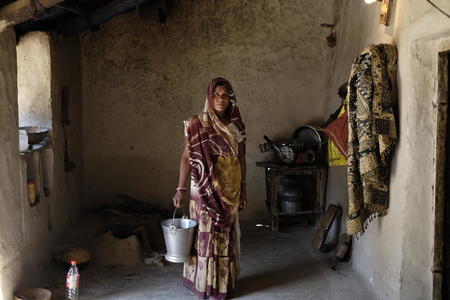Wild Water: why we need to build resilience in the face of climate change

We know that 663 million people are already struggling to access clean water due to poor management of services, social inequalities and population growth. But there’s another growing issue that’s compounding the problem: wild water. This World Water Day Florence Stuart-Leach, Digital Editor at WaterAid UK, discusses the findings of WaterAid’s new report.
The term ‘wild water’ relates to unpredictable weather patterns that can induce storm surges, flooding, prolonged droughts and the contamination of water sources.
Essentially, climate change is water change, and extreme weather events like these are only set to become more commonplace over the next 30 years. Affecting the world’s poorest people first – and worst – they will exacerbate the situation for the 663 million people who already lack access to clean water. The OECD predicts that by 2050 over 40% of the global population is likely to be living in areas under ‘severe water stress’.1
It's #WorldWaterDay - but 663 MILLION people worldwide still don't have access to clean water. That's not right. Please RT if you agree. pic.twitter.com/Bcgn3YrxPW
— WaterAid Internat'l (@wateraid) March 22, 2017
WaterAid’s new report highlights how improving rural communities’ access to clean water, sanitation and hygiene can help them become more resilient in the face of climate change.
Worst in the world for rural water
The report reveals that with 63 million people in rural areas without clean water – almost the entire population of the United Kingdom – India holds the unenviable title of having the greatest number of rural people without access to clean water.
India is a middle-income country with a fast-growing economy, but ensuring a reliable water supply for all is still one of its biggest challenges and droughts have become commonplace in many regions.
“In this far-off village, there is no source of livelihood except farming … Whatever little we were able to sow, we are consuming it cautiously as we can never be sure of rainfall next season,” says Chhoti, a mother of four, who lives in a drought-prone village called Kubri in Uttar Pradesh.
In summer, a government-operated water tanker service delivers water to the village, but it isn’t enough: “There are around 15 members in my family and the tanker gives us four cans of water. Sometimes kids fight as there is very little water left and we are not sure when the tanker will arrive again.”
See the top 10 countries with the greatest numbers of rural people without clean water
Great strides, incoming tides
Since 1990 a staggering 2.6 billion people have gained access to clean water for the first time, helping to increase their resilience to climate change and wild water events.
Among the most-improved countries for rural access to water supply is Malawi where 84% of the population lives in rural areas.
In 2015 severe flooding left 145,000 people across the country displaced, and 620 cholera cases were reported. When flooding cuts villagers off from boreholes, they are forced to collect dirty water from overflowing rivers instead, making transmission of disease much easier.
One school in Nsanje district demonstrates how the introduction of a reliable supply of clean water, adequate toilets and hygiene training can boost resilience to diseases and infections.
“In the past, we used to have a lot of students suffering from trachoma,” says deputy head teacher at Mgoma School. “At times, we would have four to five students reporting sick from each class. It was devastating and unbearable for us teachers as well as the young people.”
However Malawi’s progress is now threatened by the impact of worsening droughts and floods, and weak government systems for ensuring access to water continues and despite the improvements, 11% of the rural population is still without reliable access to clean, safe water and erratic rainfall plays havoc on people’s health and livelihoods. There is still much to be done.
See the top 10 most-improved countries for rural water access
What WaterAid is calling for
To enable some of the world’s poorest countries to adapt to climate change, what must come first and foremost is reliable access to clean water. We’re calling for the following:
- An increase in public and private financing for water, sanitation and hygiene.
- Recognition of the importance of water, sanitation and hygiene (WASH) in building resilience to climate change.
- An integrated approach from governments to improving WASH by embedding these plans in areas including health, education and gender equality.
- Governments to keep the promises they made at the 2015 Paris climate summit including an increase in global finance for climate adaptation.
- Equitable allocation of climate finance, based on climate vulnerability and need (so far, less than a third of available funds is reaching the least-developed countries).
- Increased efforts by government leaders to meet their commitments to the Global Goals, including Global Goal 6: to reach everyone everywhere with clean water, adequate sanitation and hygiene by 2030.
Download the report to read more case studies, and find out where your country ranks in the full list of nations by rural water supply.
Florence Stuart-Leach tweets as @floss422
1. OECD (2013) Water and climate Change adaptation: policies to navigate nchartered waters, OECD studies on water, OECD Publishing, Chapter 1, p23- 24.




